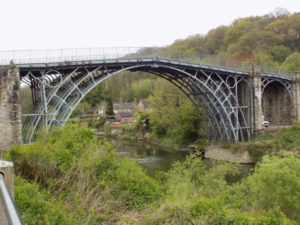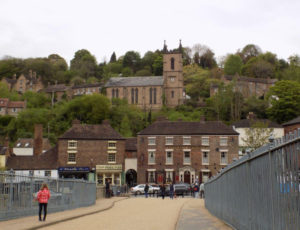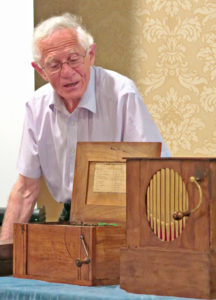Spring 2017 Meeting in Ironbridge
The historic, and naturally beautiful, Ironbridge Gorge near Telford proved to be a popular venue for the Spring 2017 National Meeting, with the Valley View Hotel earning accolades from members for the standard of food and friendliness of the staff. Its setting, with grounds leading down to a stream, was also much appreciated.
Due to another function being held in the hotel, we had our traditional Society Dinner on Friday night, affording people the opportunity afterwards to catch up with long-standing friends, some of whom have not been to a meeting in a while, and whom we were pleased to welcome back. On Saturday members had a choice of which of the local museums they visited, with no fewer than ten award-winning venues on offer.
The group passport ticket, which nevertheless allowed them to visit as individuals, proved to be excellent value, as repeat visits can be made for up to a year, as well as visits to those museums still to be visited for the first time even after a year has lapsed. It was difficult to decide which one to visit first, although the fine weather meant that many opted for the Blists Hill Victorian Village. With much of interest to detain people there, many ventured no further.
Meanwhile the Ironbridge Valley Museum offered a comprehensive overview of the valley and its historical significance. Given the tranquillity of its semi-rural appearance today, it is difficult to believe that in the late 18th century it was a the most industrialised area in the world.. This was due to the rare combination of iron ore, limestone, coal, clay and sand, all found by the banks of the river Severn, which also offered a source of power as well as the most efficient means of transport in those days.
The balmy weather was conducive for exploring the town itself, and lingering at one of the many outdoor bars and cafés. If you sat for long enough you were sure to see other MBSGB members enjoying their visit.
Saturday’s dinner was still an exclusive event despite our being relegated to the hotel’s public dining room. We had been advised we were sharing the hotel with a wedding group, but for once no one seemed to have cause for complaint.
Sunday morning we returned to the private room in the hotel for a series of workshops. Roy Evett continued his presentation on the simple maintenance of disc musical boxes, and ably demonstrated that there is nothing simple about it, hopefully with enough caveats to ensure that anyone doing this for the first time takes good advice from someone more experienced. Much time was spent on describing the cleaning of the comb.
Kath Turner, who had been prevented by other engagements from participating fully in the weekend, came along and talked about how she had found on eBay, and then restored, an unusual automaton with musical movement, the main attraction consisting of a monkey cycling to the accompaniment of an animal orchestra. Suggestions came from the floor as to what some of the remaining missing parts might be.
Gordon Bartlet demonstrated two serinettes, around 200 years apart in manufacture. The older was made around 1820, probably in Mirecourt in France. The second was reconstructed by Gordon with parts obtained from Kevin McElhone. The tune sheet for a serinette dating from 1820 included Pop Goes, probably written by the apprentice who had been instructed to copy the first two words of each title. After playing the inevitable Pop Goes the Weasel on this instrument, Gordon played the same tune on his new machine, having pinned one of three barrels with nursery tunes.
Terry Longhurst demonstrated two cylinder boxes on the theme of trills as ornamentation. One, an early box dating around 1832, by an unknown maker, but likely to be a LeCoultre, serial number 4184, played six airs on an 8¼" cylinder. The other, a Ducommun-Girod around 1850, serial number 26085, played eight airs on a 13" cylinder.
John Phillips demonstrated a jig he had constructed for setting Symphonion gantries, before finally, we were all entertained by a video of Joe Rinaudo playing the American photoplayer. It was astonishing to learn that these instruments had originally been made in their thousands, but only about 45 are now known to survive. Such a shame!
A buffet lunch was supplied at the hotel after which members drifted off home, some lingering for extended chats before departing.



